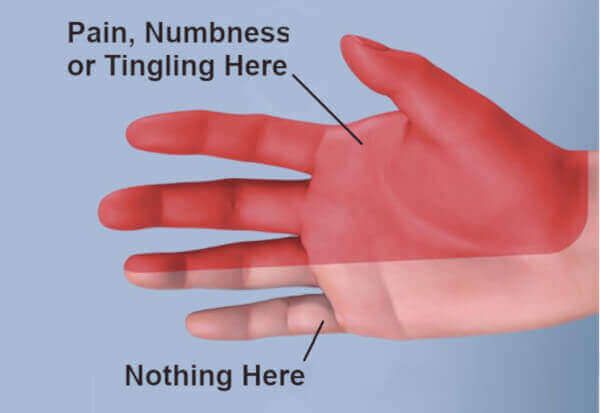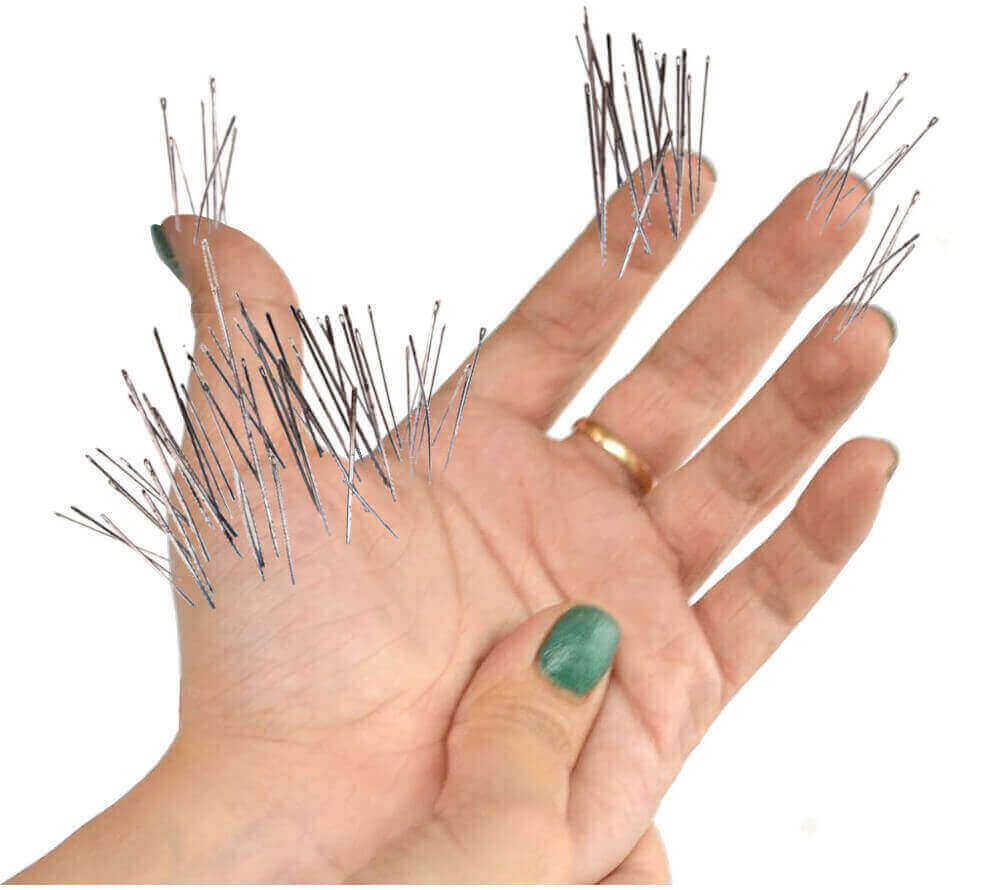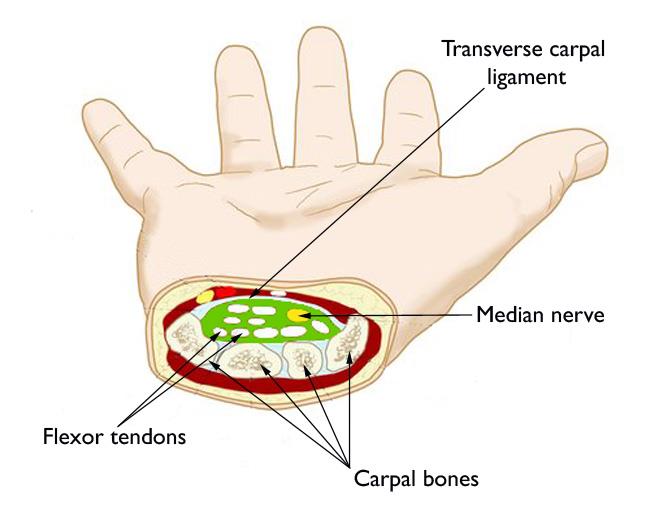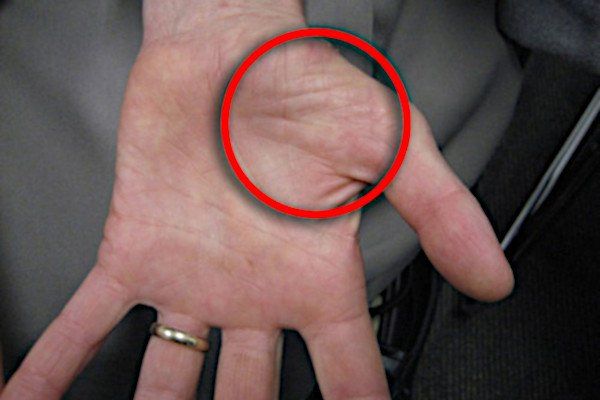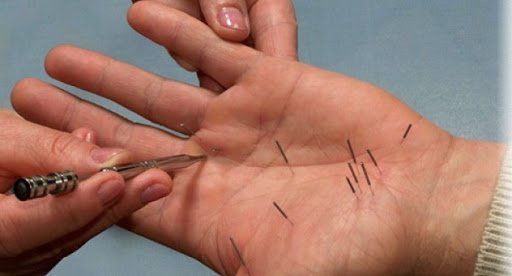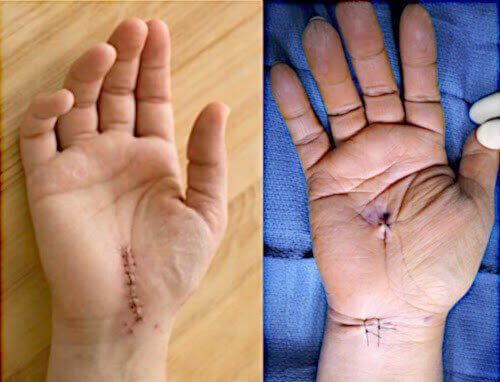Where Carpal Tunnel Pain Hurts the Most
Table of Contents
- Overview
- How carpal tunnel happens
- Carpal tunnel symptoms
- Types of painful feelings
- Carpal tunnel stages
- Mild stage
- Moderate stage
- Severe stage
- End stage
- Carpal tunnel pain relief
- Temporary pain treatments
1) Pain pills
2) Topical ointments
3) Ice baths
4) Yoga
5) Ultrasound
6) Acupuncture
- Permanent pain treatments
1) Bracing at night
2) Rest
3) Exercises
4) Massage
- A note about carpal tunnel release surgery
- Summary
- FAQs
- About
Overview
Exactly where carpal tunnel pain hurts the most varies from person to person. That's because everybody experiences
symptoms of carpal tunnel syndrome a little differently. In general, pain is usually the
major
symptom, followed by numbness and tingling (or pins & needles). The pain can be on any finger except the little (pinky) finger. It can also include the entire palm of the hand and even the wrist. Sometimes pain shoots from the fingers, through the hand and up the arm.
How carpal tunnel happens
Carpal tunnel syndrome (sometimes just called "carpal tunnel") is a progressive and painful neurological condition. And it's very common, affecting at least five million Americans.
The condition can occur for a variety of reasons. Pregnancy, rheumatoid arthritis, lupus, wrist fracture, and diabetes are some of these reasons. But by for the most common is a result of straining or stressing your hand and fingers. This happens when you perform certain
harmful hand activities, like repetitive or rapid and forceful hand movements for a long time (called
repetitive stress). Wrist flexor tendons tend to react badly to such stress. (The flexor tendons are the structures responsible for curling your fingers.)
Over time and a lot of stress, the tendons become
inflamed and start to show signs of swelling. That’s when problems really go downhill.
Carpal tunnel symptoms
The tendons swell inside the wrist joint in a tight space called the “carpal tunnel”. It's a narrow, crowded passageway through which your hand's tendons and the
median nerve pass.
Unfortunately, the swelling
pushes on the adjacent median nerve. With enough time, the swelling slowly crushes the nerve. The crushed nerve is what produces all of the sensations of carpal tunnel syndrome - especially pain. You feel the pain in the fingers, palm, or wrist. Along with pain, other carpal tunnel symptoms include:
Usually, the place where carpal tunnel pain hurts the most is the palm of the hand, thumb, and first (pointer) finger. It's common for the fingertips or the thumb's base to hurt more.
Carpal tunnel pain can be constant or intermittent. The pain is unusual in that it hurts even when you're not using your hand. In fact, most often the pain is worse when you're resting or even trying to sleep. This distinguishes carpal tunnel syndrome from
wrist tendonitis pain.
People with moderate to
severe carpal tunnel tend to wake up in the middle of the night. The severe pain makes them want to rub the pain out. With numbness, they feel the need to shake out their numb hand.
Types of painful feelings
As describe above, the
place where carpal tunnel pain hurts the most is easy to define. But describing the actual
type of pain patients feel is more difficult.
The types of pain reported have a wide range. They can be anywhere from
annoying or bothersome to
crushing or punishing. The specific
qualities of pain sensations usually described are:
- burning
- throbbing
- pounding
- sharp
- dull
- deep
- grinding
- aching
- shooting
Note that you can have only one or all of these pain sensations at the same time. Usually having more than one type of pain sensation is relative to the
stage of carpal tunnel syndrome you're in.
More advanced stages produce additional types of pain sensations.
Carpal tunnel stages
Mild stage
The
mild stage is where carpal tunnel pain is either annoying or just bothersome. It may occasionally wake you at night. Actually, by the time most people realize there's a problem, the condition is already well-developed.
Moderate stage
The moderate stage
is more advanced. It's where carpal tunnel pain keeps you awake at night AND during the daytime. Usually this pain or numbness ranges from severe to excruciating. Hand weakness and
loss of grip strength become noticeable.
Severe stage
The
severe stage where carpal tunnel pain is described as "crushing, cruel or punishing". And the pain is ever-present; a non-stop, 24/7 problem. Essentially, there is no rest from the intense pain or numbness. Weakness, clumsiness, and loss of temperature sensitivity are severe.
End stage
End stage carpal tunnel syndrome is the terminal phase. Ironically, pain diminishes because the pain fibers in the median nerve have died. Numbness and tingling can persist. But your hand is essentially useless, losing most of its gripping abilities. Most notably, the
thenar muscle (at the base of your thumb) flatten out and wrinkle because most of them have degenerated (atrophied).
Carpal tunnel pain relief
For most people, it doesn't matter where carpal tunnel pain is as long as they can treat it. But it may surprise you that treating the pain symptoms is only slightly helpful. Treating the
cause
of the pain (swollen tendons) is far more effective and lasting. In other words:
If you treat
only the pain
it will come back. But if you treat the
cause of the pain
it will eliminate symptoms forever. Therefore, where carpal tunnel
pain
is your main symptom, there are 2 approaches to treating it:
- Temporary pain treatments which just treat pain for the time being
- Permanent pain treatments which treat & eliminate the source of the pain
Most doctors recommend you use the permanent pain treatments for obvious reasons. The image below shows the most popular pain relievers. You've probably tried them - with no long-term effects.
Temporary pain treatments
Pain pills
Drugs in the form of "pain pills" (analgesics) are the most common way to help patients where carpal tunnel pain is the primary symptom. Specifically, over-the-counter
non-steroidal anti-inflammatory drugs or NSAIDs are most popular. These include Advil, Motrin, Tylenol, Aleve, Naproxen and Aspirin. While these drugs do offer some relief from the pain, it's only temporary -- usually lasting a few hours. Moreover,
according to the FDA, it's dangerous to take these drugs daily for more than a few weeks due to the elevated risks of liver or kidney damage, heart attack, and stroke.
Topical ointments
The most common topical ointment for carpal tunnel is
Biofreeze. Patients say they apply it where carpal tunnel pain is most intense, like the thumb or forefinger. And it undoubtedly can help ease the pain - likely due to its
powerful placebo effect. But like pain medicines, the relief is only temporary because it doesn't address the
cause of the pain.
Ice baths
Most patients have say they use ice baths for their hand pain. Others say ice-followed by warm water (called "contrast baths") works well also. Again, this may relieve pain for a few minutes after you pull your hand out of the bath. Then the temporary relief wears off and you're back at the starting line again.
Yoga
Study after study shows that yoga can
improve symptoms of carpal tunnel syndrome. Its effects are likely due to stretching the area where carpal tunnel pain is most concentrated. While yoga is considered a temporary pain reliever, isolated
carpal tunnel stretches (see below) are more permanent treatments.
Ultrasound
Therapeutic ultrasound is
beneficial for temporary carpal tunnel pain relief. Ultrasound therapy warms the carpal tunnel area. The warmth encourages the healing process and also reduces pain levels. Applying ultrasound over a several week period can reduce painful symptoms. But after the course of therapy ceases, pain usually returns.
Acupuncture
Several reliable studies have shown that acupuncture can reduce carpal tunnel symptoms significantly. Nobody is certain how acupuncture works as a pain reliever, but the effects are strong - if only temporary. The effects last 1-3 days after the acupuncture treatment. Again, this is a temporary treatment because the acupuncture therapy doesn't address the root cause of the disorder.
Permanent pain treatments
The most successful remedy used by doctors and therapists is actually a "combination therapy". It includes Bracing, Rest, Exercise, and Massage. These 4 combined treatments actually target the
source of carpal tunnel syndrome: tendon swelling. The effects are usually complete and permanent. The combined therapies must be used together and for a period of about 4 weeks to see lasting results.
Bracing at night
Start bracing your hand while you sleep. Even though your thumb or finger is where carpal tunnel hurts the most, the pain actually comes from
deep inside your wrist joint. Make sure you use a
certified carpal tunnel night brace and not just a generic wrist brace from the drug store. (Those generic braces can do more harm than good.) Also,
never wear a wrist brace during the daytime if you have carpal tunnel syndrome. Doing so makes your hand subconsciously fight the brace in addition to doing its regular work. That makes the problem in your wrist much worse.
Rest
Rest is the best treatment for any injury, especially for a repetitive stress injury. So rest your hands as often as you can when you work. Never maintain a constant grip on a hand tool like a saw or
hair brush. Also, never perform continued grip-and-release activities with your hands without resting and stretching them in between.
Exercises
Stretching exercises for your fingers and hands are crucial. Specifically designed
carpal tunnel stretching exercises limber up your fingers and therefore your flexor tendons. This is perhaps the
best way to avoid ever having hand pain to begin with.
Massage
Massage is by far the most powerful carpal tunnel fighter. Specifically, you must use the
myofascial release massage technique for maximum benefit. To do this, a therapist digs their thumbs into your forearm, just below your wrist crease. Then they make circular, counter-rotating motions for a few minutes. (The
CarpalRx does it automatically.) This action breaks up
adhesions and restrictions that cause tendon inflammation and swelling. It also encourages fluid drainage and promotes blood flow. The downside is you cannot perform myofascial release massage on yourself.
A note about carpal tunnel release surgery
You'll note that
carpal tunnel release surgery is not mentioned as a permanent pain treatment. That's because it isn't. Surgery doesn't eliminate the cause of the problem, which is tendon swelling.
Surgery merely depressurizes the area for a limited period of time. And that's why pain relief is temporary. In fact, where carpal tunnel pain was the main symptom,
about 50% of post-surgical patients saw pain return by 2 years after their hand operation.
Why? Because surgery doesn't eliminate the source of the pain, which is tendon swelling.
Summary
The place where carpal tunnel pain hurts the most is different for everybody. However, most often patients feel more pain in the thumb and first finger. The pain can range from mild to crushing. It can also remain in one area or shoot up your arm. Most people treating the pain on a temporary basis. But attacking the
cause of the pain will bring lasting, permanent relief.
FAQs
- Are damaged flexor tendons the only way to get carpal tunnel?
No, any condition which leads to swelling inside the wrist joint can cause it. These conditions include pregnancy, rheumatoid arthritis, lupus, wrist fracture, and diabetes.
- Does carpal tunnel always progress to the end stage?
No, symptoms can level out in any stage. However, carpal tunnel is a progressive disorder. That means it usually advances, and rarely resolves by itself without treatment.
- How can I tell if I have carpal tunnel syndrome versus something else?
You can visit your doctor for a full diagnosis. You can also perform this
self-test to determine if you have carpal tunnel versus tendonitis.
About


